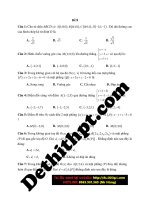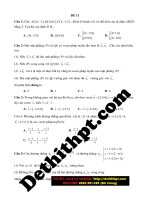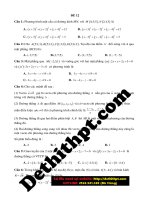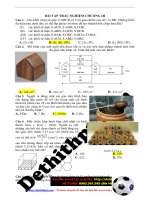Đề 49 image marked image marked
Bạn đang xem bản rút gọn của tài liệu. Xem và tải ngay bản đầy đủ của tài liệu tại đây (1.43 MB, 8 trang )
Exercise 49:
Read the following passage and mark the letter A, B, C or D to indicate the correct answer to each
of the questions.
When jazz began to lose its reputation as "low-down" music and to gain well-deserved
acclaim among intellectuals, musicians began to feature many instruments previously
considered inappropriate for jazz. Whereas before the 1950s, jazz musicians played only
eight basic instruments in strict tempo, in this decade they started to improvise on the flite,
electric organ, piccolo, accordion, cello, and even bagpipes, with the rhythm section
composed for strings or piano. Big bands no longer dominated jazz, and most changes
emerged from small combos, such as the Dave Brubeck Quartet and the Gerry Mulligan
Quartet. The Gerry Mulligan Quartet proved that a small, modern band could sound
complete without a piano; the rhythm section consisted only of a set of drums and a string
bass.
Đăng ký file Word tại link sau
/>
Jazz continued to move in new directions during the 1960s. Saxophonist and composer
Ornette Coleman led a quartet playing "free" jazz that was atonal. Pianist Cecil Taylor also
Trang 1
conducted similar experiments with music, and John Coltrane included melodies from
India in his compositions. In the 1970s musicians blended jazz and rock music into fusion
jazz which combined the melodies and the improvisations of jazz with the rhythmic
qualities of rock'n' roll, with three or five beats to the bar and in other meters. The form of
jazz music was greatly affected by electric instruments and electronic implements to
intensify, distort, or amplify their sounds. However, the younger musicians of the time felt
compelled to include a steady, swinging rhythm which they saw as a permanent and
essential element in great jazz.
QUESTION
Question 1: Which of the following would be the best title for the passage?
A. Quintessential Moments in Jazz Music
B. Popular Beats in Classical and Modern Jazz
C. The Achievements of Famous Jazz Musicians
D. The Rising Prestige and Diversity of Jazz
Question 2: The passage implies that representative jazz musicians _________
A. concentrated on melodious combinations of sounds
B. blended improvisations and sheet music together
C. created and modernized sophisticated devices
D. sought novel techniques in form and content
Question 3: According to the passage, the changes in jazz music in the 1970s came from________
A. ambitious aspirations
B. sound amplifiations
C. another harmonious scale
D. another musical trend
Question 4: The word "compelled" at the end of paragraph 2 in the passage is closest in meaning to
___________.
A. forced
B. challenged
C. obligated
D. censored
Trang 2
Question 5: The paragraph preceding this passage would most likely describe ______________
A. instruments used in jazz
B. the origins of jazz
C. jazz in the 1940s
D. instrumental pieces in jazz
Question 6: The author believes that the developments in jazz described in the passage ____________
A. appear largely suggestive
B. may be perceived as discrete
C. should be considered influential
D. should be seen as precocious
Question 7: The author of the passage implies that in the 1950s, jazz musicians ____________
A .strictly adhered to its traditions and compositions
B. experimented with rhythm and instruments
C. probably continued with its tempo and instrumentation
D. increased the tempo to keep up with the changes
Question 8: Which of the following best describes the organization of the passage?
A. Chronological innovations in jazz music
B. Definitions of diverse jazz styles
C. A classification of prominent jazz musicians
D. Descriptions and examples to illustrate jazz rhythm
Question 9: It can be inferred from the passage that small jazz bands ______.
A. consisted of drums and a string bass
B. included modern sound systems
C. were innovative in their music
D. were dominated by large orchestras
Question 10: The author of the passage mentions all of the following EXCEPT ________.
A. string bass
B. harpsichord
C. bagpipes
D. percussion
GIẢI CHI TIẾT
Question 1: Which of the following would be the best title for the passage?
A. Quintessential Moments in Jazz Music
B. Popular Beats in Classical and Modern Jazz
Trang 3
C. The Achievements of Famous Jazz Musicians
D. The Rising Prestige and Diversity of Jazz
Dịch nghĩa: Dòng nào sau đây là nhan đề phù hợp nhất với bài văn?
A. Thời đại hoàn hảo nhất của nhạc Jazz
B. Những giai điệu phổ biến trong nhạc Jazz cổ điển và hiện đại
C. Thành tựu của một số nhạc sĩ nhạc Jazz nổi tiếng
D. Sự trân trọng ngày càng tăng và sự đa dạng của nhạc Jazz
Giải thích: Đoạn đầu tác giả viết về cái nhìn trân trọng hơn của mọi người về nhạc jazz: "When jazz
began to lose its reputation as "low-down" music and to gain well-deserved acclaim among intellectuals,
musicians began to feature many instruments previously considered inappropriate for jazz"(Khi nhạc jazz
bắt đầu giảm đi tai tiếng như là loại nhạc"hèn mọn" và nhận được những lời tung hô từ những người trí
thức, những nhạc sĩ bắt đầu cải tiến những nhạc cụ mà trước đây được coi là không phù hợp với jazz)
Đoạn 2 tác giả viết về sự đa dạng của nhạc jazz khi có kết hợp với nhiều thể loại âm nhạc cũng như
những nhạc cụ mới
Question 2: The passage implies that representative jazz musicians _________
A. concentrated on melodious combinations of sounds
B. blended improvisations and sheet music together
C. created and modernized sophisticated devices
D. sought novel techniques in form and content
Dịch nghĩa: Bài văn ngụ ý rằng những nhạc sĩ đại diện cho nhạc jazz__________
A. tập chung vào sự kết hợp của các giai điệu
B. trộn lẫn sự sáng tác ngẫu hứng với những bản nhạc giấy với nhau
C. tạo ra và cách tân những nhạc cụ phức tạp
D. tìm kiếm kĩ thuật mới trong cả hình thức và nội dung
Giải thích: "Whereas before the 1950s, jazz musicians played only eight basic instruments in strict
tempo, in this decade they started to improvise on the flute, electric organ, piccolo, accordion, cello, and
even bagpipes, with the rhythm section composed for strings or piano." (Trong khi trước những năm
1950, nhạc sĩ nhạc jazz chỉ chơi tám loại nhạc cụ cơ bản theo nhịp phách nghiêm ngặt thì thập kỉ này họ
bắt đầu ngẫu hứng dùng thêm sáo, đàn organ điện, ống sáo nhỏ, đàn accordion, cello, và thậm chí là kèn
túi cùng với những giai điệu được sáng tác cho đàn dây hoặc piano)
Trang 4
Question 3: According to the passage, the changes in jazz music in the 1970s came from________
A. ambitious aspirations
B. sound amplifiations
C. another harmonious scale
D. another musical trend
Dịch nghĩa: Theo như bài văn, những thay đổi trong nhạc jazz trong những năm 1970 xuất phát từ ____.
A. Tham vọng lớn
B. Sự khuếch đại âm thanh
C. Quy mô hài hòa khác
D. Xu hướng âm nhạc khác
Giải thích: "Jazz continued to move in new directions during the 1960s" (Nhạc Jazz tiếp tục chuyển theo
một xu hướng mới trong suốt những năm 1960)
Question 4: The word "compelled" at the end of paragraph 2 in the passage is closest in meaning to
___________.
A. forced
B. challenged
C. obligated
D. censored
Dịch nghĩa: Từ "compelled" cuối đoạn 2 có nghĩa gần nhất với ____.
A Bị ai ép buộc
B. Bị thử thách
C Bản thân tự buộc phải làm gì
D. Bị kiểm duyệt
Question 5: The paragraph preceding this passage would most likely describe ______________
A. instruments used in jazz
B. the origins of jazz
C. jazz in the 1940s
D. instrumental pieces in jazz
Dịch nghĩa: Đoạn văn trước bài văn này sẽ có thể nói về _________
A. nhạc cụ được sử dụng trong nhạc jazz
B. nguồn gốc của nhạc jazz
C. nhạc jazz trong những năm 1940
D. những bản nhạc trong nhạc jazz
Giải thích: Theo trình tự thời gian của đoạn văn, đoạn đầu tác giả nói về nhạc jazz trong những năm
1950, đoạn sau nói về nhạc jazz trong những năm 1960=> đoạn trước của đoạn đầu sẽ nói về nhạc jazz
trong những năm 1940.
Question 6: The author believes that the developments in jazz described in the passage
A. appear largely suggestive
B. may be perceived as discrete
C. should be considered influential
D. should be seen as precocious
Dịch nghĩa: Tác giả tin rằng sự phát triển nhạc jazz được miêu tả trong bài văn____.
A. dường như mang tính khởi xướng
B. dường như được nhận thức trừu tượng
C. nên được coi trọng
D. nên được nhìn nhận như là sự phát triển sớm
Trang 5
Giải thích: Cả bài văn tác giả đã nói về những cải tiến nhạc jazz bằng giọng trân trọng
Question 7: The author of the passage implies that in the 1950s, jazz musicians ____________
A. strictly adhered to its traditions and compositions
B. experimented with rhythm and instruments
C. probably continued with its tempo and instrumentation
D. increased the tempo to keep up with the changes
Dịch nghĩa: Tác giả ngụ ý rằng trong những năm 1950, những nhạc sĩ nhạc jazz ________.
A. nghiêm khắc tuân theo âm nhạc và nhạc cụ truyền thống
B. thí nghiệm với những loại phách mới và nhạc cụ mới
C. tiếp tục với loại phách và nhạc cụ cũ
D. tăng phách để theo kịp với sự thay đổi
Giải thích: "Whereas before the 1950s, jazz musicians played only eight basic instruments in strict
tempo, in this decade they started to improvise on the flute, electric organ, piccolo, accordion, cello, and
even bagpipes, with the rhythm section composed for strings or piano." (Trong khi trước những năm
1950, nhạc sĩ nhạc jazz chỉ chơi tám loại nhạc cụ cơ bản theo quy trình nghiêm ngặt thì thập kỉ này họ
bắt đầu cải tiến dùng thêm sáo, đàn organ điện, ống sáo nhỏ, đàn accordion, cello, và thậm chí là kèn túi
cùng với những giai điệu được sáng tác cho đàn dây hoặc piano)
Question 8: Which of the following best describes the organization of the passage?
A. Chronological innovations in jazz music
B. Definitions of diverse jazz styles
C. A classification of prominent jazz musicians
D. Descriptions and examples to illustrate jazz rhythm
Dịch nghĩa: Dòng nào miêu tả cách tổ chức của bài văn?
A. Sự cải tiến theo trình tự thời gian của nhạc jazz
B. Định nghĩa những thể loại nhạc jazz
C. Sự phân loại những nhạc sĩ nhạc jazz
D. Miêu tả và ví dụ để minh họa giai điệu nhạc jazz
Giải thích: mỗi đoạn văn tác giả lại miêu tả những sự cải tiến trong nhạc jazz qua từng thập kỉ
Trang 6
Question 9: It can be inferred from the passage that small jazz bands ______.
A. consisted of drums and a string bass
B. included modern sound systems
C. were innovative in their music
D. were dominated by large orchestras
Dịch nghĩa: Có thể suy ra từ đoạn văn là những ban nhạc jazz nhỏ _______.
A. bao gồm trống và bass dây
B. bao gồm hệ thống âm thanh hiện đại
C. sáng tạo tiến bộ trong âm nhạc của họ D. bị mất ưu thế bởi những dàn hòa nhạc lớn
Giải thích: "Big bands no longer dominated jazz, and most changes emerged from small combos, such as
the Dave Brubeck Quartet and the Gerry Mulligan Quartet.The Gerry Mulligan Quartet proved that a
small, modern band could sound complete without a piano, the rhythm section consisted only of a set of
drums and a string bass" (Những ban nhạc lớn không còn chiếm ưu thế về nhạc Jazz và hầu hết những
thay đổi này xuất phát từ những nhóm nhỏ là ban nhạc chỉ gồm 4 người Dave Brubeck và Gerry
Mulligan. Ban nhạc Gerry Mulligan chứng minh rằng những nhóm nhỏ, hiện đại vẫn có thể chơi nhạc
hoàn hảo mà hoàn toàn thiếu piano và giai điệu của họ chỉ bao gồm trống và bass dây.)
Question 10: The author of the passage mentions all of the following EXCEPT ________.
A. string bass
B. harpsichord
C. bagpipes
D. percussion
Dịch nghĩa: Tác giả đề cập đến tất cả các loại nhạc cụ ngoại trừ _.
A. bass dây
B. đàn phong cầm
c. kèn túi
D. trống
Giải thích: "in this decade they started to improvise on the flute, electric organ, piccolo, accordion, cello,
and even bagpipes, with the rhythm section composed for strings or piano" (thập kỉ này họ bắt đầu cải
tiến dùng thêm sáo, đàn organ điện, ống sáo nhỏ, đàn accordion, cello, và thậm chí là kèn túi cùng với
những giai điệu được sáng tác cho đàn dây hoặc piano) "The Gerry Mulligan Quartet proved that a small,
modern band could sound complete without a piano, the rhythm section consisted only of a set of drums
and a string bass" (Ban nhạc Gerry Mulligan chứng minh rằng những nhóm nhỏ, hiện đại vẫn có thể chơi
nhạc hoàn hảo mà hoàn toàn thiếu piano và giai điệu của họ chỉ bao gồm trống và bass dây)
DỊCH BÀI
Khi nhạc jazz bắt đầu không còn bị xem như thứ âm nhạc "hèn mọn" và nhận được những lời ca ngợi
xứng đáng từ giới trí thức, các nhạc sĩ bắt đầu đề cao nhiều nhạc cụ mà trước đây được coi là không phù
hợp với nhạc jazz. Trong khi trước những năm 1950, nhạc sĩ nhạc jazz chỉ chơi tám loại nhạc cụ cơ bản
theo nhịp phách nghiêm ngặt thì thập kỉ này họ bắt đầu cải tiến dùng thêm sáo, đàn organ điện, ống sáo
nhỏ, đàn accordion, cello, và thậm chí là kèn túi cùng với những giai điệu được sáng tác cho đàn dây hoặc
piano. Những ban nhạc lớn không còn chiếm ưu thế về nhạc Jazz và hầu hết những thay đổi này xuất phát
Trang 7
từ những nhóm nhỏ là ban nhạc chỉ gồm 4 người Dave Brubeck và Gerry Mulligan. Ban nhạc Gerry
Mulligan chứng minh rằng những nhóm nhỏ, hiện đại vẫn có thể chơi nhạc hoàn hảo mà không cần piano
và giai điệu của họ chỉ bao gồm trống và dây bass.
Nhạc Jazz tiếp tục chuyển theo một xu hướng mới trong suốt những năm 1960, một nghệ sĩ kèn
saxophone và nhạc sĩ Ornette Coleman đã dẫn đầu một ban nhạc 4 người "free" jazz loại nhạc mà không
có bản nhạc. Nghệ sĩ piano Cecil Taylor cũng thí nghiệm tương tự với âm nhạc và John Coltrane cũng
thêm giai điệu từ Ấn Độ trong chất nhạc của ông ấy. Vào những năm 1970 những nhạc sĩ trộn jazz và
nhạc rock tạo thành thể loại nhạc jazz tổng hợp, loại nhạc mà kết hợp giữa giai điệu và sự cải tiến nhạc
jazz với nhịp điệu của rock'n roll, cùng với 3 hoặc 5 nhịp trong một thanh nhạc. Sự hình thành nhạc jazz
ảnh hưởng lớn bởi nhạc cụ điện tử và những dụng cụ kích âm để làm tăng cường độ, làm biến đổi hoặc
khuếch đại âm thanh của nó lên. Tuy nhiên, những nhạc sĩ trẻ của thời đại cảm thấy buộc phải bao hàm
những giai điệu nhẹ nhàng bay bổng, điều mà chúng ta nghĩ là yếu tố vĩnh cửu và không thể thiếu của
nhạc jazz.
Trang 8









